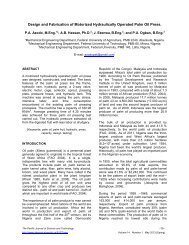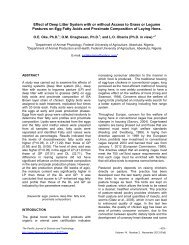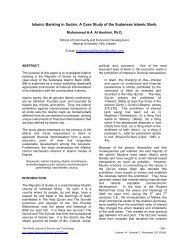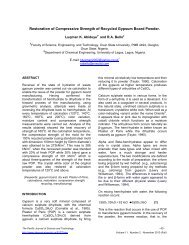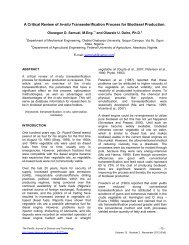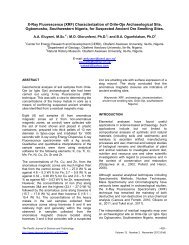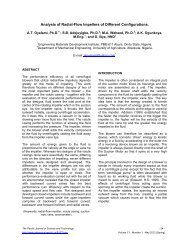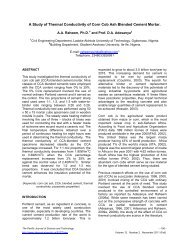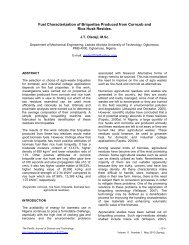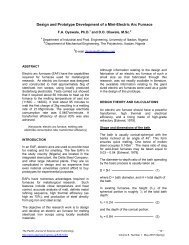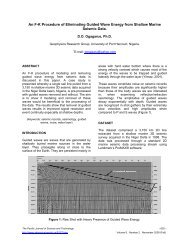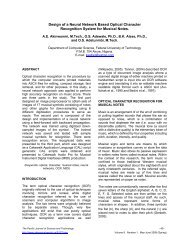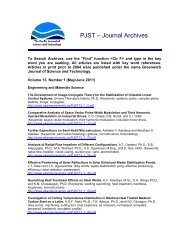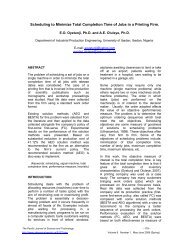Analysis of Moisture Transport in the Solar Drying of Food Items.
Analysis of Moisture Transport in the Solar Drying of Food Items.
Analysis of Moisture Transport in the Solar Drying of Food Items.
You also want an ePaper? Increase the reach of your titles
YUMPU automatically turns print PDFs into web optimized ePapers that Google loves.
Equation (10) is solved numerically by <strong>the</strong> Crank<br />
Nicolson method [5] us<strong>in</strong>g <strong>the</strong> simplification that<br />
<strong>the</strong> process <strong>of</strong> vapor diffusion is quasi-steady.<br />
Design <strong>of</strong> <strong>Solar</strong> Dryer<br />
The heat ga<strong>in</strong>ed by <strong>the</strong> dryer per unit time, Qg is<br />
given by [6]:<br />
Qd = A[Iτα – UL(Ti – Ta)]. (11)<br />
where, A = area <strong>of</strong> transparent cover (m 2 )<br />
I = <strong>in</strong>cident <strong>in</strong>solation (Wm – 2 )<br />
UL = overall heat loss for <strong>the</strong> collector (W 0 C – 1 )<br />
α = solar absorbance<br />
τ = transmittance<br />
Ti = temperature <strong>of</strong> <strong>in</strong>com<strong>in</strong>g air<br />
Ta = temperature <strong>of</strong> ambient air<br />
S<strong>in</strong>ce <strong>the</strong> dryer draws <strong>the</strong> ambient air directly, <strong>the</strong><br />
last term on <strong>the</strong> right-hand side vanishes and <strong>the</strong><br />
rate <strong>of</strong> energy collection is simply:<br />
Qd = AIτα (12)<br />
If <strong>the</strong> mass <strong>of</strong> air leav<strong>in</strong>g <strong>the</strong> dryer per unit time is<br />
m& a , <strong>the</strong> heat ga<strong>in</strong>ed by <strong>the</strong> air Qu is [7]:<br />
Qa = m& a C(To – Ti). (13)<br />
where, C = specific heat capacity <strong>of</strong> air<br />
(kJkg – 1 0 C – 1 )<br />
To = temperature <strong>of</strong> out-go<strong>in</strong>g air<br />
A simplified energy equation for <strong>the</strong> dryer is Qg =<br />
Qu, i.e.,<br />
AIτα = m& a C(To – Ti). (14)<br />
Therefore, <strong>the</strong> required surface area <strong>of</strong> <strong>the</strong><br />
transparent cover, which determ<strong>in</strong>es <strong>the</strong> size and<br />
dimensions <strong>of</strong> <strong>the</strong> dryer, is obta<strong>in</strong>ed from:<br />
( T − T )<br />
m C<br />
A = a o<br />
Iτα<br />
&<br />
i<br />
(15)<br />
The total energy required for dry<strong>in</strong>g a given<br />
quantity <strong>of</strong> food items can be estimated us<strong>in</strong>g <strong>the</strong><br />
basic energy balance equation for <strong>the</strong> evaporation<br />
<strong>of</strong> water [8]:<br />
m& w Lv = a C(To – Ti). (16)<br />
m&<br />
where, Lv = specific latent heat <strong>of</strong><br />
vaporization <strong>of</strong> water from <strong>the</strong><br />
food surface (kJ/kg)<br />
m& w = mass <strong>of</strong> water evaporated from<br />
<strong>the</strong> food item (kg s – 1 ).<br />
m&<br />
The mass <strong>of</strong> water w is estimated from <strong>the</strong><br />
<strong>in</strong>itial moisture content Mi and <strong>the</strong> f<strong>in</strong>al desired<br />
moisture content Mf as follows:<br />
⎛ M i − M<br />
⎜<br />
⎝100<br />
− M<br />
⎞<br />
⎟<br />
⎠<br />
& w = m&<br />
wc<br />
f<br />
f<br />
(17)<br />
m<br />
m&<br />
where is <strong>the</strong> mass <strong>of</strong> <strong>the</strong> wet crop or food<br />
item (kg s – 1 wc<br />
).<br />
Dur<strong>in</strong>g dry<strong>in</strong>g, water at <strong>the</strong> surface <strong>of</strong> <strong>the</strong><br />
substance evaporates and water <strong>in</strong> <strong>the</strong> <strong>in</strong>ner part<br />
migrates to <strong>the</strong> surface to get evaporated. The<br />
ease <strong>of</strong> this migration depends on <strong>the</strong> porosity <strong>of</strong><br />
<strong>the</strong> substance and <strong>the</strong> surface area available.<br />
O<strong>the</strong>r factors that may enhance quick dry<strong>in</strong>g <strong>of</strong><br />
food items are: high temperature, high w<strong>in</strong>d<br />
speed and low relative humidity.<br />
Construction <strong>of</strong> <strong>the</strong> <strong>Solar</strong> Dryer<br />
The solar cab<strong>in</strong>et dryer is shown schematically <strong>in</strong><br />
Figures 1 and 2. The transparent top cover is 4<br />
mm thick clear glass with a total surface area <strong>of</strong><br />
1.22 m by 0.90 m. The dryer cab<strong>in</strong>et is made <strong>of</strong><br />
25 mm plywood. The front is higher than <strong>the</strong> rear<br />
giv<strong>in</strong>g <strong>the</strong> top cover an <strong>in</strong>cl<strong>in</strong>ation <strong>of</strong> about 17.5 0 .<br />
This is approximately 10 0 more than <strong>the</strong> local<br />
geographical latitude (Ado-Ekiti Nigeria, 7.5 0 N),<br />
which is <strong>the</strong> best recommended orientation for<br />
stationary absorber [9]. This <strong>in</strong>cl<strong>in</strong>ation is also to<br />
allow easy run <strong>of</strong>f <strong>of</strong> water and to enhance air<br />
circulation.<br />
Vents were made at <strong>the</strong> low end <strong>of</strong> <strong>the</strong> front <strong>of</strong><br />
<strong>the</strong> cab<strong>in</strong>et and at <strong>the</strong> upper end <strong>of</strong> <strong>the</strong> back <strong>of</strong><br />
<strong>the</strong> cab<strong>in</strong>et to facilitate and control <strong>the</strong><br />
convectional flow <strong>of</strong> air through <strong>the</strong> dryer. A<br />
dry<strong>in</strong>g tray was constructed with wire mesh,<br />
which fitted snugly and covered <strong>the</strong> entire floor <strong>of</strong><br />
<strong>the</strong> dryer. Access door was also provided at <strong>the</strong><br />
back <strong>of</strong> <strong>the</strong> cab<strong>in</strong>et to allow <strong>the</strong> load<strong>in</strong>g <strong>of</strong> <strong>the</strong><br />
dry<strong>in</strong>g tray with food items.<br />
The dryer is a passive system <strong>in</strong> <strong>the</strong> sense that it<br />
has no mov<strong>in</strong>g parts. It is energized by <strong>the</strong> sun’s<br />
The Pacific Journal <strong>of</strong> Science and Technology –642–<br />
http://www.akamaiuniversity.us/PJST.htm Volume 9. Number 2. November 2008 (Fall)



